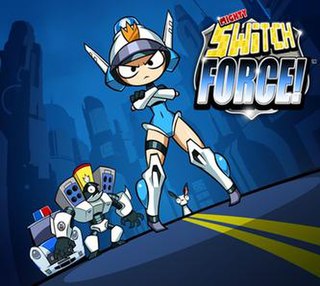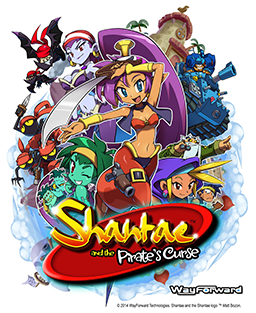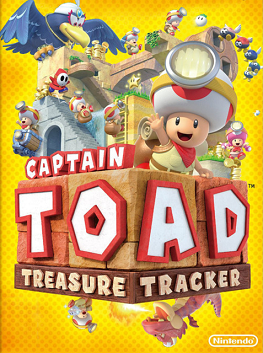
Wario's Woods is a puzzle video game developed and published by Nintendo. It was released in Japan and North America in 1994 and Europe in 1995 for both the Nintendo Entertainment System and the Super Nintendo Entertainment System. A spin-off of the Mario series, players control Toad in his mission to defeat Wario, who has taken control of the Peaceful Woods. Gameplay revolves around clearing each level by using bombs to destroy groups of enemies. The game also features a multiplayer mode that allows two players to compete against each other.

Dr. Robotnik's Mean Bean Machine is a falling block puzzle game developed by Compile and published by Sega. It was released for the Sega Genesis / Mega Drive in North America and Europe in November 1993, and ported to the Game Gear in 1993 and Master System in 1994.

Super Puzzle Fighter II Turbo, released in Japan as Super Puzzle Fighter II X, is a tile-matching puzzle video game released in 1996 for the CP System II (CPS2) arcade board, by Capcom and its Capcom Coin-Op division. The game's title is a play on Super Street Fighter II Turbo, as there were no other Puzzle Fighter games at the time, and the game includes music and interface elements spoofing the Street Fighter Alpha and Darkstalkers games. It was a response to Sega's Puyo Puyo 2 that had been sweeping the Japanese arcade scene.
Super Smash Bros. is a crossover platform fighting game series published by Nintendo. The series was created by Masahiro Sakurai, who has directed every game in the series. The series is known for its unique gameplay objective which differs from that of traditional fighters, in that the aim is to increase damage counters and knock opponents off the stage instead of depleting life bars.

Mario's Picross is a 1995 puzzle video game for the Game Boy. Developed by Jupiter and Ape and published by Nintendo, it is a compilation of nonogram logic puzzles. The game stars Mario who chisels away at puzzle grids to form pictures. The game initially received positive reviews, with reviewers citing its length and addictive nature as a positive, but its grid sizes and absence of typical Mario elements as a negative.
WayForward Technologies, Inc. is an American independent video game developer and publisher based in Valencia, California. Founded in March 1990 by technology entrepreneur Voldi Way, WayForward started by developing games for consoles such as the Super NES and Sega Genesis, as well as TV games and PC educational software. In 1997, they relaunched their video games arm, placing the company as a contractor for publishers and working on a variety of licensed assets.
indieszero Corporation, Ltd. is a small video game development company headquartered in Musashino, Tokyo, Japan. It was founded on April 21, 1997, and has developed video games for other video game companies, including Nintendo, SEGA, and Square Enix.

Mario is a Japanese multimedia franchise created by Japanese game designer Shigeru Miyamoto for video game company Nintendo, which produces and publishes its installments. Starring the titular Italian plumber Mario, it is primarily a video game franchise but has extended to other forms of media, including television series, comic books, a 1993 feature film, a 2023 animated film, and theme park attractions. The series' first installment was 1983's Mario Bros. even though Mario made his first appearance in 1981's arcade game Donkey Kong and had already been featured in several games of the Donkey Kong and Game & Watch series. The Mario games have been developed by a wide variety of developers. Mario games have been released almost exclusively for Nintendo's various video game consoles and handhelds, from the third generation onward.

Mighty Switch Force! is a puzzle-platform game developed by WayForward Technologies for Nintendo 3DS. It is the third game in WayForward's Mighty series, following Mighty Flip Champs! and Mighty Milky Way. The game was released on the Nintendo eShop on December 22, 2011. An update to the game, including five new levels, was released on May 24, 2012. A high-definition version, Mighty Switch Force! Hyper Drive Edition, was released for the Wii U in 2012, featuring re-drawn graphics and other new features. A Steam version of the game was also released in June 2015. A sequel, Mighty Switch Force! 2, was released in June 2013.

Theatrhythm Final Fantasy is a rhythm video game, developed by indieszero and published by Square Enix for Nintendo 3DS and iOS. Based on the Final Fantasy video game franchise, the game involves using the touch screen in time to various pieces of music from the series. The game was released in Japan in February 2012, and in North America, Australia and Europe in July. An iOS version was released in December. A sequel, Theatrhythm Final Fantasy: Curtain Call, was released in 2014. A third game based on the Dragon Quest series, Theatrhythm Dragon Quest, was released in 2015. An arcade game, Theatrhythm Final Fantasy: All-Star Carnival, was released in 2016. A second sequel, Theatrhythm Final Bar Line, was released on February 16, 2023, for Nintendo Switch and PlayStation 4.

Shantae and the Pirate's Curse is a platform game developed by WayForward Technologies for the Nintendo 3DS and the Wii U. It is the third game in the Shantae series, following Shantae: Risky's Revenge, and the first to be developed for a home console. It was released in North America on the 3DS eShop on October 23, 2014 and on the Wii U eShop on December 25, 2014, and in PAL regions on both platforms on February 5, 2015. The game was later ported to PlayStation 4, PlayStation 5, Xbox One, Microsoft Windows, Amazon Fire TV, Nintendo Switch, and Amazon Luna. The game follows the adventures of the eponymous half-genie Shantae as she once again has to save Sequin Land from a new foe, the Pirate Master, with help from her nemesis Risky Boots.

Mighty Switch Force! 2 is a puzzle platformer developed and published by WayForward Technologies for the Nintendo 3DS. It is the fourth game in WayForward's Mighty series and the sequel to 2011's Mighty Switch Force!. The game was released on the Nintendo eShop on June 13, 2013 in North America and in the PAL regions on June 27. The game was later released for the Wii U in October the same year. A puzzle game using similar elements and assets, Mighty Switch Force! Hose It Down!, was released for iOS on February 12, 2015 and for Microsoft Windows on June 4.

Puyo Puyo Tetris is a 2014 puzzle video game developed by Sonic Team and published by Sega. The game is a crossover between the Puyo Puyo series and the Tetris franchise, and features various gameplay modes incorporating both aspects. The game includes characters modeled and named after the seven Tetrominos, which are different puzzle pieces each made of four blocks.

Captain Toad: Treasure Tracker is a 2014 action puzzle video game developed and published by Nintendo for the Wii U. The game was re-released for the Nintendo Switch and Nintendo 3DS in 2018 with additional content. It is a spin-off of the Super Mario series and a part of the larger Mario franchise. The game stars Captain Toad and Toadette as they complete levels, defeat enemies and save each other from the antagonist Wingo. Each level is contained within a miniature diorama-like environment that requires puzzle-solving and platforming challenges to complete. The player also uses the Wii U GamePad to rotate the camera and reveal new information and interact with the environment.

Layton's Mystery Journey: Katrielle and the Millionaires' Conspiracy is a 2017 puzzle video game by Level-5. It is the seventh main entry in the Professor Layton series and follows a new protagonist, Katrielle Layton. It was released for Android, iOS, and the Nintendo 3DS, in 2017, and an enhanced port for the Nintendo Switch in Japan in 2018, and worldwide in 2019. A manga adaptation of the game drawn by Hori Oritoka began serialization on March 20, 2018, in Shōgakukan's Ciao magazine, and an anime adaptation, Layton Mystery Tanteisha: Katori no Nazotoki File, began airing on Fuji TV and other channels in April 2018.

The Electronic Entertainment Expo 2017 was the 23rd E3, during which hardware manufacturers and software developers and publishers from the video game industry presented new and upcoming products to the attendees, primarily retailers and members of the video game press. The event, organized by the Entertainment Software Association (ESA), took place at the Los Angeles Convention Center from June 13–15, 2017. It was the first E3 to allow public access to the event, and as a result, the total attendance was about 68,400 which included 15,000 in public passes.

Bye-Bye BoxBoy! is a puzzle-platform game developed by HAL Laboratory and published by Nintendo for the Nintendo 3DS. The third game in the BoxBoy! series, it was released worldwide in 2017. The game was followed by BoxBoy! + BoxGirl! for the Nintendo Switch in 2019.

Go! Go! Kokopolo 3D: Space Recipe for Disaster is a 2017 action puzzle platform video game, and sequel to the 2011 DSiWare game Go! Go! Kokopolo: Harmonious Forest Revenge. Developed by Tanukii Studios Limited, and published by Circle Entertainment, the game features 80 new stages, 10 new bosses, a completely new story, as well as other bonus modes and secrets.

BoxBoy! is a series of puzzle-platform games developed by HAL Laboratory and published by Nintendo. The series centres around Qbby, a square-shaped character who can produce a string of connected boxes. The boxes are used to overcome obstacles in stages that Qbby must be guided through. The first game, BoxBoy!, released on January 14, 2015, in Japan on the Nintendo 3DS. Its sequel, BoxBoxBoy!, was released for the Nintendo 3DS in 2016, with a third game, Bye-Bye BoxBoy!, in 2017. A physical compilation of the first three games, HakoBoy! Hakozume Box, was released in Japan. A fourth installment, BoxBoy! + BoxGirl!, was released for the Nintendo Switch in April 2019.

Dr Kawashima's Brain Training for Nintendo Switch is an edutainment puzzle video game developed by Nintendo and indieszero and published by Nintendo for the Nintendo Switch. It is the fifth entry in the Brain Age puzzle video game series, based on the research of neuroscientist Ryuta Kawashima, whose avatar guides the player through the game. It was released on December 27, 2019 in Japan, January 3, 2020 in Europe and Australia, and July 1, 2020 in South Korea. The game was not released in North America.

















